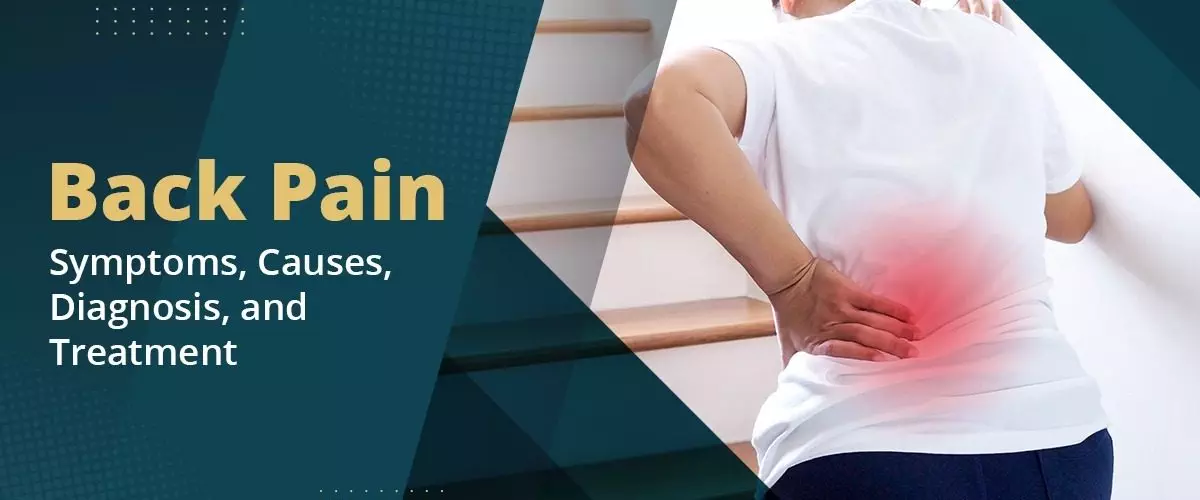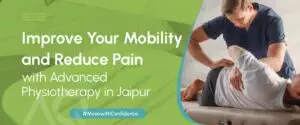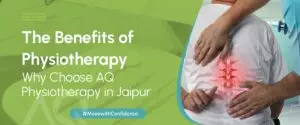In the bustling city of Jaipur, where tradition and modernity...
Read More
Back Pain, Symptoms, Causes, Diagnosis, and Treatment
Back Pain is one of the common problems nowadays for seeking medical treatment. Back pain is painful, uncomfortable, annoying, impair the strength, and ask for an instant check-up.
Back Pain is a condition that can affect people of any age. It can be the result of any activity, medical condition, or injury. As people grow older, the chances of back pain endure and enhance more, because of their prior occupation and degenerative disk disease.
Back Pain is separated into two Lower Pain and Upper Pain. Lower Pain is promoted due to the discs between the vertebrae, bony lumbar spine, spinal cord and nerves, ligaments around the spine and discs, lower back muscles, abdominal and pelvic internal organs, and the skin around the lumbar area.
Upper Pain is linked to complications of the aorta, tumors in the chest, and spine inflammation.
1. Back Pain Home Remedies
Some of the natural home remedies for back pain-
- Heat and Ice therapy
- Exercises
- Hand-On therapy
- Talk therapy
- Stretches
- Good Sleep
- Better Diet
- Maintain good posture
- Quit smoking
- Rub on Medicated Creams
2. Back Pain Causes
The human back is incorporated of a complex structure that includes tendons, bones, discs, ligaments, and bones which work together to perform the process, support the body, and help it to move around.
If any of the above does not function properly, then this problem leads to back pain.
The inappropriate function of these parts can be due to strain, medical conditions, or poor posture.
The most common back pain causes are-
(a). Strain
- Muscle spasm
- Muscle tension
- Damaged disks
- Injuries, fractures, falls
- Strained muscles or ligaments
- Lifting something heavy, improper, or making an awkward movement.
(b). Structural Problems
- Ruptured disks
- Kidney problems
- Osteoporosis
- Abnormal curvature of the spine
- Arthritis
- Sciatica
- Bulging disks
- Ruptured disks
(c). Movement and posture
- Over-stretching
- Twisting
- Muscle tension
- Coughing and sneezing
- Bending improperly for a long time.
- Standing or sitting for a long time.
- Pushing, lifting, pulling, or carrying something.
- Long driving sessions without a break.
- Sleeping on a mattress that is not supportive.
(d). Other Causes
- Shingles
- Sleep disorders
- Cancer of the spine
- Infection of the spine
- Cauda equina syndrome
3. Back Pain Symptoms
The back pain occurs due to ache or pain anywhere in the backside, down in the buttocks, legs., or any part of the body where nerves are affected. Sometimes pain often goes away without any major treatment, but if it occurs due to the following condition then you should immediately visit a doctor. The common back pain symptoms are:
- Fever
- Weight loss
- Difficulty during urinating
- Numbness around the genitals
- Numbness around the anus
- Numbness around the buttocks
- Urinary incontinence
- Continue back pain, where lying or resting does not help
- Inflammation or swelling on the back
- Pain down the legs
- Fecal Incontinence
- Loss of control over bowel movements
- Pain that goes below the knees
4. Back Pain Diagnosis
Diagnosis is suggested by a neurosurgeon based on symptoms, history, physical examination, and results of diagnostic studies. Some patients may require conservative treatment, but if conservative treatment doesn’t work then physicians may order another test like-
- X-rays
- Selective Nerve Root Block
- Myelogram
- Nerve Conduction Studies
- Discography
- Computed Tomography Scan
- Electromyography
5. How to prevent Back Pain
Here are a few ways the prevention of back pain and make your back muscles strong. s
- Do back pain and stretching exercises regularly to avoid back pain.
- Make sure you maintain a neutral pelvic position while standing. It means to stand upright, head facing forward, back straight, and balance your weight on both feet. Legs should be straight and your head in line with your spine.
- While sitting, make sure you should have good back support, a good seat, armrests, and a swivel base. While sitting, level your knees and hips, and keep your feet on the floor or use a footstool.
- Do not lift heavy objects. In case, if you do, then bend your knees and keep your back straight. This way, your leg muscles will perform most of the task without causing any back pain.
- Live an active lifestyle and eat healthily. Being overweight can force your back, and cause you trouble doing any job. Doing regular physical activity, exercise, and choosing healthy foods will help you stay healthy and fit.
- Avoid smoking as smokers have a high risk of back pain.
6. Risk Factors for Back Pain
Below-mentioned is the risk factors for back pain that are associated with a higher risk of developing back pain:
- Smoking
- Pregnancy
- Old age
- Bad physical fitness
- Medical conditions like arthritis and cancer
- Occupational activities
- Excess weight
- Physical work done incorrectly
- Sedentary lifestyle
- Stress, anxiety, and mood disorders
7. Back Pain Treatment
Follow the below steps for back pain treatment-
(a). Medication
Back Pain can strain you both mentally and physically. It also leads to frustration, irritability, depression, and other psychological aspects, so to maintain all of these you may be referred to a rehabilitation psychologist. Here, you may be recommended meditation, yoga, and other relaxation strategies to keep your mind away from any type of pain.
(b). Diets
Some food materials are high in inflammation particularly those high in refined sugars, trans fat, and processed foods. So, it is better to consult your doctor and how you can change it, as your diet can also contribute to back pain. An active and fit body can lessen your back pain and the pressure on your spine.
(c). Topical rubs and ointments
Topical products are found very much effective to reduce back pain, as they contain ingredients like ibuprofen and lidocaine. They come in the form of creams, gels, lotions, patches, and sprays.
(d). Muscle relaxants
Muscle relaxants are also productive for lower back pain, particularly if muscle spasms are found next to pain. They also act on the central nervous system to lower down pain.
(e). Antidepressants
Antidepressants and other medications can also be used off-label to cure back pain.
If your back pain is severe, then your doctor may suggest amitriptyline, a tricyclic antidepressant, as they focus on the different parts of the pain. It may also work great for nerve-related pain.
(f). Other medicine
Other therapies that combat back pain include-
- Acupuncture
- Massage
- Relaxation techniques
- Cognitive-behavioral therapy
- Chiropractic adjustments
Remember, to talk with your doctor before undergoing any of the above therapies.
(g). Steroid Injections
For the back, pain doctors may also prescribe cortisone steroid injections for back pain Like, a person with back pain linked with nerve may get a cortisone steroid injection.
8. Exercises to help your Back Pain
The best recommended exercises to help your back pain will surely provide relief from all types of back pain if performed daily and correctly. These include:
(a). Knee to Chest Stretch
- Lie on your back with your knees bent and your feet flat touching the floor.
- Now with both hands, bring one knee closer to your chest.
- Tighten your abdominals and press your spine to the floor.
- Hold the posture for 5 minutes, return to the starting position, and repeat the process with another leg.
- Return to the starting position, and then repeat the process with both the legs.
- Repeat the whole process 2-3 times in the morning.
(b). Lower back rotational stretch
- Lie on your back with your knees bent and your feet flat touching the floor.
- Keeping your shoulders firmly on the floor, roll your bent knees to one side, and hold the posture for 5-10 seconds.
- Repeat the same process to another side.
- Repeat the whole process 2-3 times in the morning.
(c). Lower Back flexibility exercise
- Lie on your back with your knees bent and your feet flat touching the floor.
- Tighten your abdominal muscles so that your stomach pulls up from the waistband.
- Hold the posture for 5 seconds and then relax.
- Flatten your back, pulling your belly button resting towards the floor.
- Repeat the process 5 times every day in the morning.
(d). Bridge Pose
- Lie on your back with your knees bent and your feet flat touching the floor.
- Keep your shoulders held firm on the ground, tighten your abdominal and gluteal muscles.
- Raise your hips in a way that a straight line is formed from your knees to your shoulder.
- Hold the posture to complete three deep breaths.
- Return to the starting point and then repeat the process five times in the morning.
(e). Cat stretch
- Position yourself on your knees and hands similar.
- Slowly stretch your back, as if you are pulling your abdomen upwards.
- Then slowly let your back go down.
- Remember to perform the exercise in the same position. Don’t lie on the floor.
- Return to the starting position and do the exercise 3-5 times a day.
(f). Seated lower back rotational stretch
- Take an armless chair or stool. Cross your right leg over your left one.
- Place our left elbow against the outside of your right knee.
- Twist and stretch to the side.
- Hold the posture for 10 seconds.
- Repeat the same with the opposite side.
- Do the process 3-5 times in the morning.
(g). Shoulder Squeeze
- Sit on a process armless chair or stool.
- Sit in a comfortable position, and squeeze your shoulder.
- Maintain the posture for 5 minutes.
- Repeat the process 3-5 times a day.
How Can We Help You?
Have Any Query Regarding our Services, Contact us at aqhealthcare or fix an appointment.
Specialities
- Joint Replacement
- Hip Replacement
- Knee Replacement
- Sports Injury
- Ligament Surgeon
- Physiotherapist Service
Recent Posts
The Benefits of Physiotherapy: Why Choose AQ Physiotherapy in Jaipur
In the bustling city of Jaipur, where the pursuit of...
Read MoreHow Physiotherapy helps in Back Pain, Knee Pain, and Sports Injuries
In the realm of physical rehabilitation, physiotherapy stands as a...
Read MoreWorld Class Robotic Neuro Rehab Department
all about World Class Robotic Neuro Rehab:- How is stroke...
Read More



